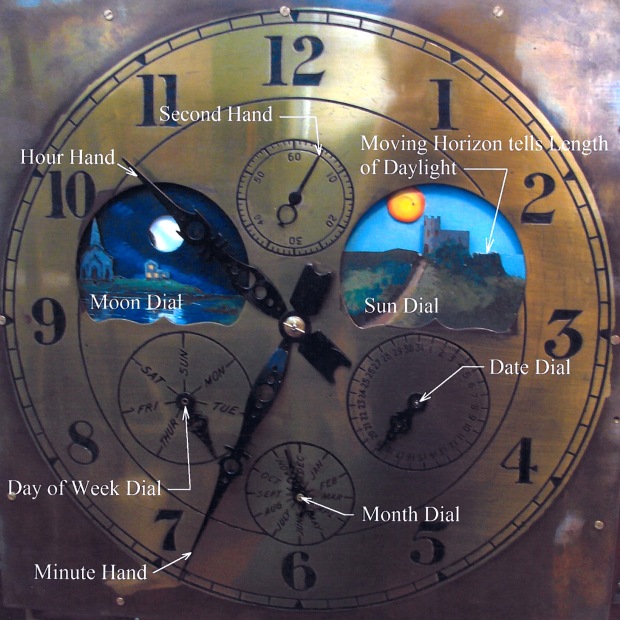What has an Apostles train that parades every 30 minutes, shows the moon phases, the location of the sun in the sky, and tells you the day and month all at once? Our Apostolic Clock!

(If you aren’t familiar with the clock, you can read more about it here and here)
If you are familiar with any of our social media platforms (Instagram, twitter, Facebook), you would have seen that the Apostolic Clock has taken up residence in the entryway of the museum and has resumed enchanting guests with its parade of Apostles. However, you might not have known about some of its mysteries!
Did you know that…
- The clock has three different parts that have to be wound at different times? The Apostles parade every 30 minutes so they wind down the fastest; they have to be re-wound every 2 days – if they aren’t, they become stuck 1/3 of the way on parade!
- Originally, the Apostles paraded on the hour, but it was altered to parade every 30 minutes at the request of museum staff. Marv DeBoy who worked on the clock with Mr. Albert Bull from 1974 onwards, made the modifications.
- Today, the Apostles come out of a set of doors that opens inward. The doors used to be glued together and opened outward as a single door.
- All of the Apostles are hand carved and painted wooden figures. While very similar, they differ slightly in the position of their hands, the clothing arrangement and colour and hairstyle.
- At the top of the clock, there are mysterious metal fixtures that seem to have no purpose. Fred Robjent and Chris Tahk, our wonderful volunteers who have helped maintain the clock for years, have not yet found a purpose for them! Do you know what they are for?
- There is a hole on the left side that may or may not have been for a light switch. What the light may have illuminated is a still a mystery.

- The face of the clock has two larger dials that have painted tin plates of scenery (one even has a castle!) that move independently of each other to mimic moon phases and the movement of the sun.
- The moon dial completes a single revolution ever 91 days and is propelled by a lead weight (which is unusual in design and construction[1])
- The dial with the sun completes a revolution every 24 hours (for 24 hours in a day). What is very interesting though is that the tin plate is mounted on vertical guides – these move the horizon up and down to reflect the winter solstice (at the highest point) and the summer solstice (at the lowest point)!
- The 8-inch terrestrial globe at the bottom of the clock rotates once every 24 hours and is very fragile! It has been conserved at the State University College at Buffalo Art Conservation Department twice: once in 2002 and then in 2008. In 2008, wooden dowels were attached inside to help give the globe more structure. Below are some great ‘After Treatment’ images from its last visit to the Art Conservation Department.

Now that you know a little more about our clock, you should come for a visit and see how many of these you can spot! Have you seen any other mysteries about the clock? We’d love to hear any answers or theories – even more mysteries!
Britt Call,
THE GREG D. TRANTER COLLECTION MANAGER
[1] P41. HAGANS, Orville R. “The Myles Hughes Apostolic Clock.” Watch & Clock Review 50.8 (August 1983): 40-43.

